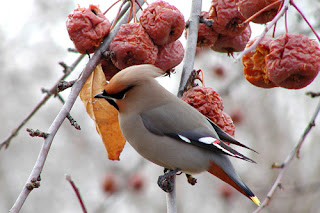By Naush Boghossian, Staff Writer
Source
A few dozen bird watchers swooped into the Valley on Saturday, peering into trees and into the blue sky above, on the lookout for the winged and the feathery.
The excursion by bird watchers with the San Fernando Valley chapter of the National Audubon Society makes the local group one of the first in the country to participate in the 108th annual Christmas Bird Count.
Audubon groups started the count Friday, and it runs to Jan. 5. The goal is to document numbers and types of birds and keep tabs on how birds are faring in a changing environment.
"We have records going back more than 100 years, and it's proven to be extremely valuable ... to track the impacts of developments and global warming," said Garrison Frost, spokesman for Audubon California.
Bird watchers get to engage in a favorite pastime and contribute to science at the same time. Arthur Langton of West Hills, who has taken part in almost every Christmas Bird Count since its inception in the late 1950s, said what keeps him coming back is the thrill of seeing the usual collection of birds, along with those that are total surprises.
Arthur Langton of West Hills, who has taken part in almost every Christmas Bird Count since its inception in the late 1950s, said what keeps him coming back is the thrill of seeing the usual collection of birds, along with those that are total surprises.
But he has noticed certain species that populated the Valley years ago are nowhere to be seen - which he attributes to development, drought and changes in the environment.
"Now you see other birds that are new, or birds that have disappeared completely because of loss of habitat," Langton said.
"Some things surprise you when they show up, and some things surprise you because they're not around."
The local bird count in the Valley divides the community into eight sections, all within a 15-mile diameter from the corner of Nordhoff Street and Balboa Boulevard. Bird enthusiasts spend all day scouring the area.
The day offers bird watchers a good test of their skills, having to identify some winged creatures by sight and others by sound.
Kris Ohlenkamp of Topanga said the highlight of his day was seeing a few unusual birds: the red-naped sapsucker, Cassin's kingbird and a marsh wren.
He caught sight of 75 species Saturday, bringing the total number of bird species he's seen this year in the United States to 486.
"It's a wow moment," Ohlenkamp said. "You see a bird you've never seen before or something you don't expect and it's really exciting. And you study up on their habitat and you go out and see it and it's a real feeling of accomplishment."
The regional bird counts done throughout the country help the Audubon Society compile data to document significant changes - not just in bird populations but also in the environment.
The society released a report last year showing steep declines in the birds people see every day - pigeons, doves and swallows.
The group also released a watch list of hundreds of birds in danger of extinction - research based on the Christmas Bird Count, Frost said.
"Birds are one of the early indicators of significant environmental change, so the bird count is about birds, but it's about more than that," Frost said.
"It's about habitat, other forms of wildlife, and ... (with) global warming, birds are among the first wildlife species that you'll start to see changes in - migration patterns change, populations rise or decline, or they move."
The Santa Clarita Valley will hold its bird count on Dec. 29. For more information, visit www.sfvaudubon.org.
skip to main |
skip to sidebar
Blog Archive
-
►
2009
(1)
- ► March 22 - March 29 (1)
-
►
2008
(4)
- ► May 25 - June 1 (3)
- ► March 23 - March 30 (1)

